Abstract
The molecular basis for activity of habekacin was studied by using Escherichia coli Q-13. Electron microscopic studies revealed that numerous blebs, derived from the outer membrane, were formed on cells treated with habekacin. Cytoplasmic contents leaked into the lumina of blebs, and the membrane of some enlarged blebs was disrupted. In a cell-free system, habekacin interfered with polypeptide synthesis, caused codon misreading, and inhibited translocation of N-acetylphenylalanyl-tRNA from the acceptor site to the donor site on ribosomes. [3H]habekacin bound to both 50S and 30S ribosomal subunits. The current experiments indicated that the mechanism of action of habekacin is similar to that of 2-deoxystreptamine-containing aminoglycoside antibiotics such as dibekacin, kanamycin, gentamicin, and related substances. The relationship of membrane damage to inhibition of ribosomal functions remains to be determined.
Full text
PDF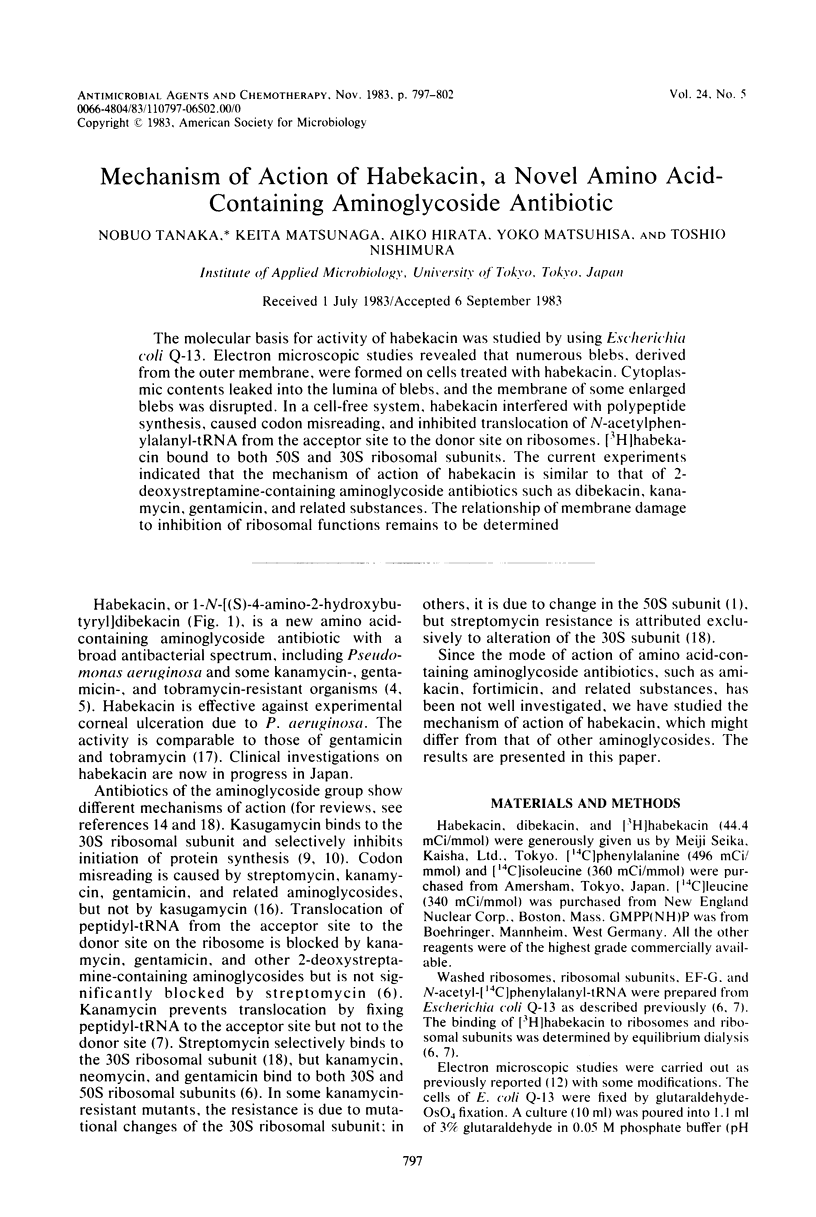

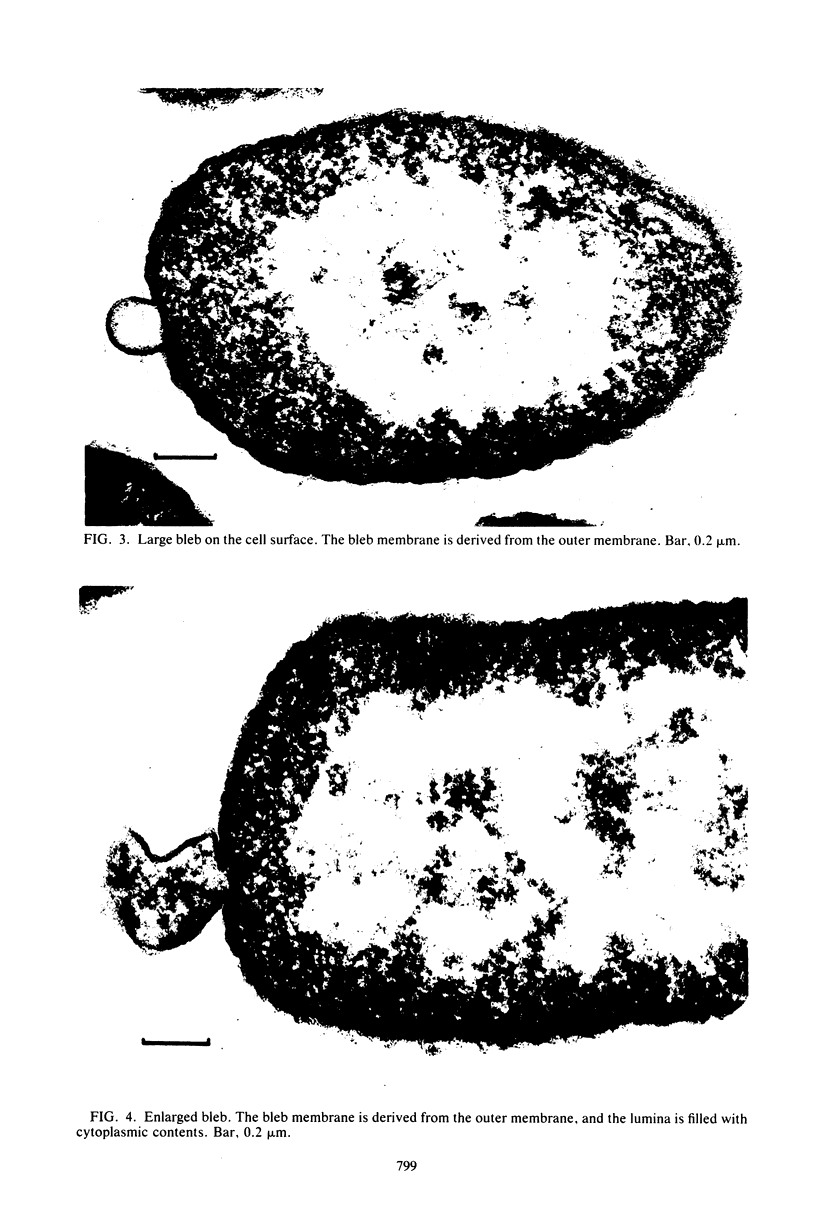
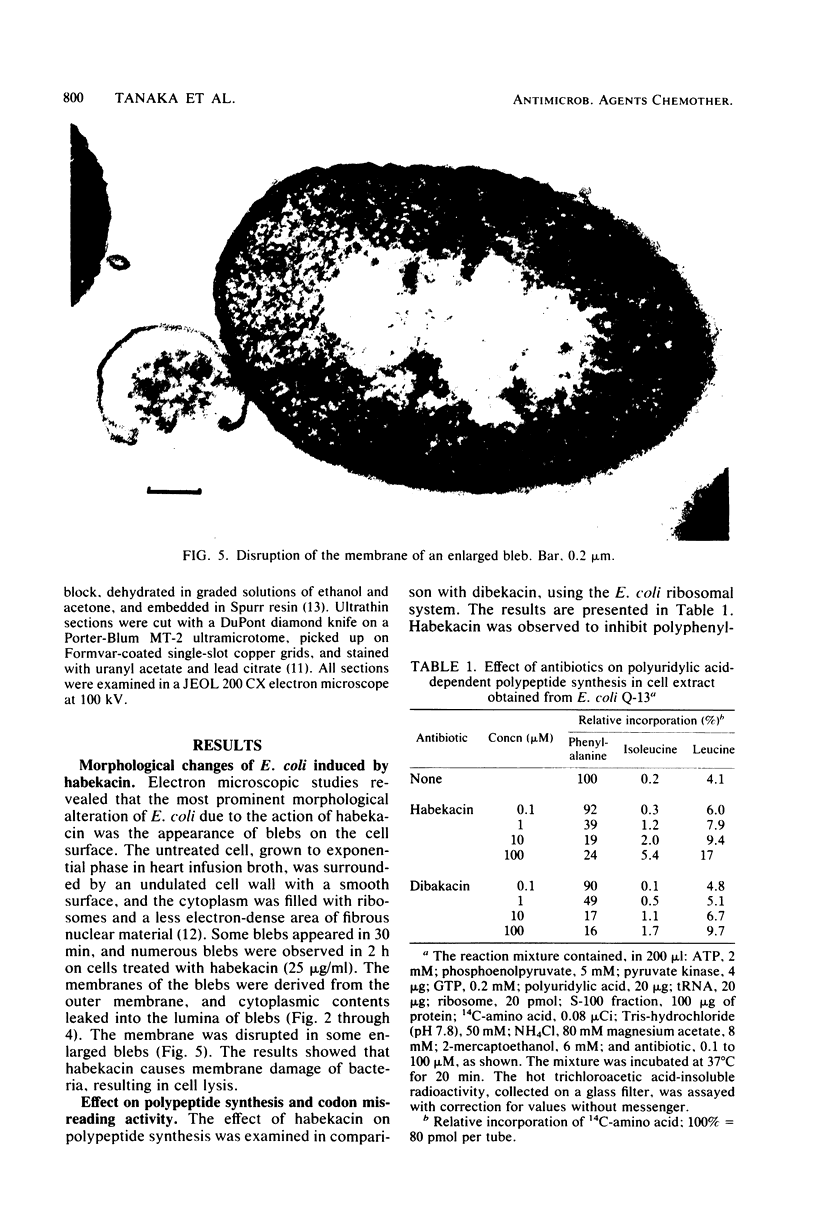
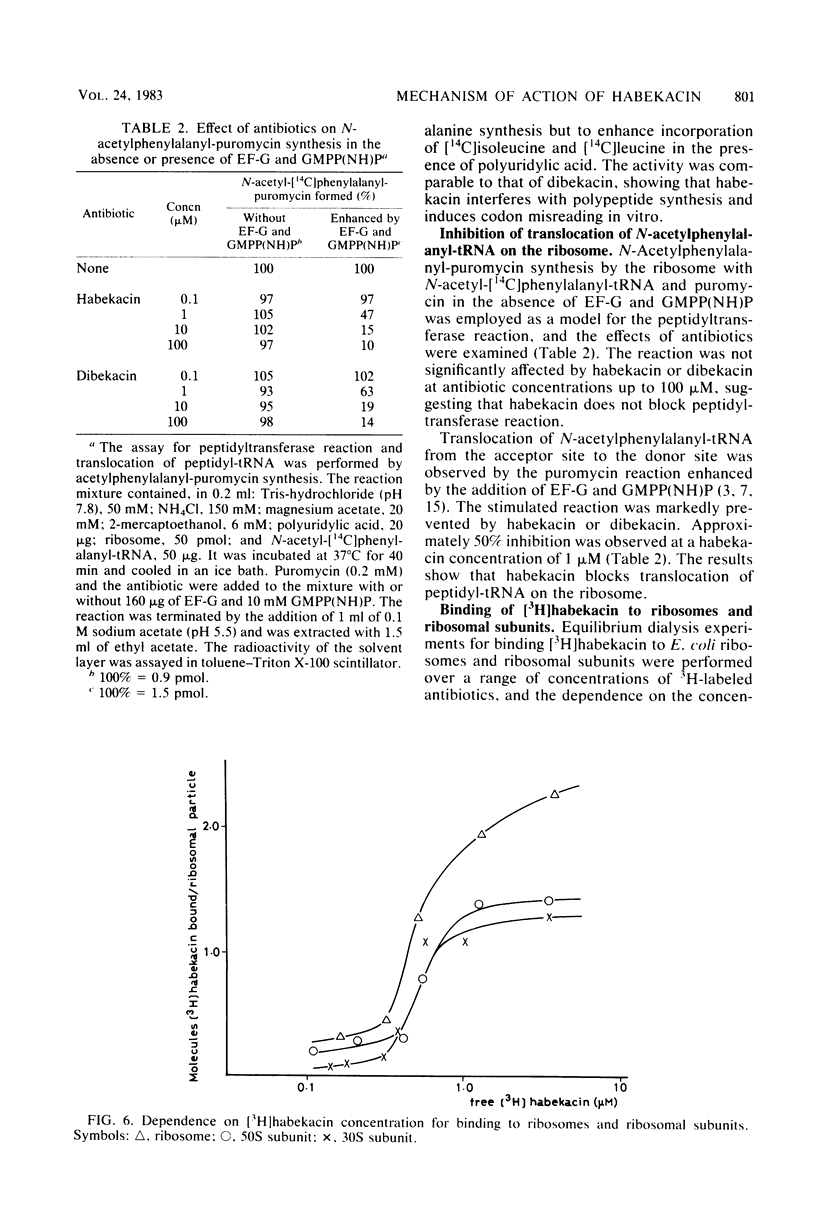
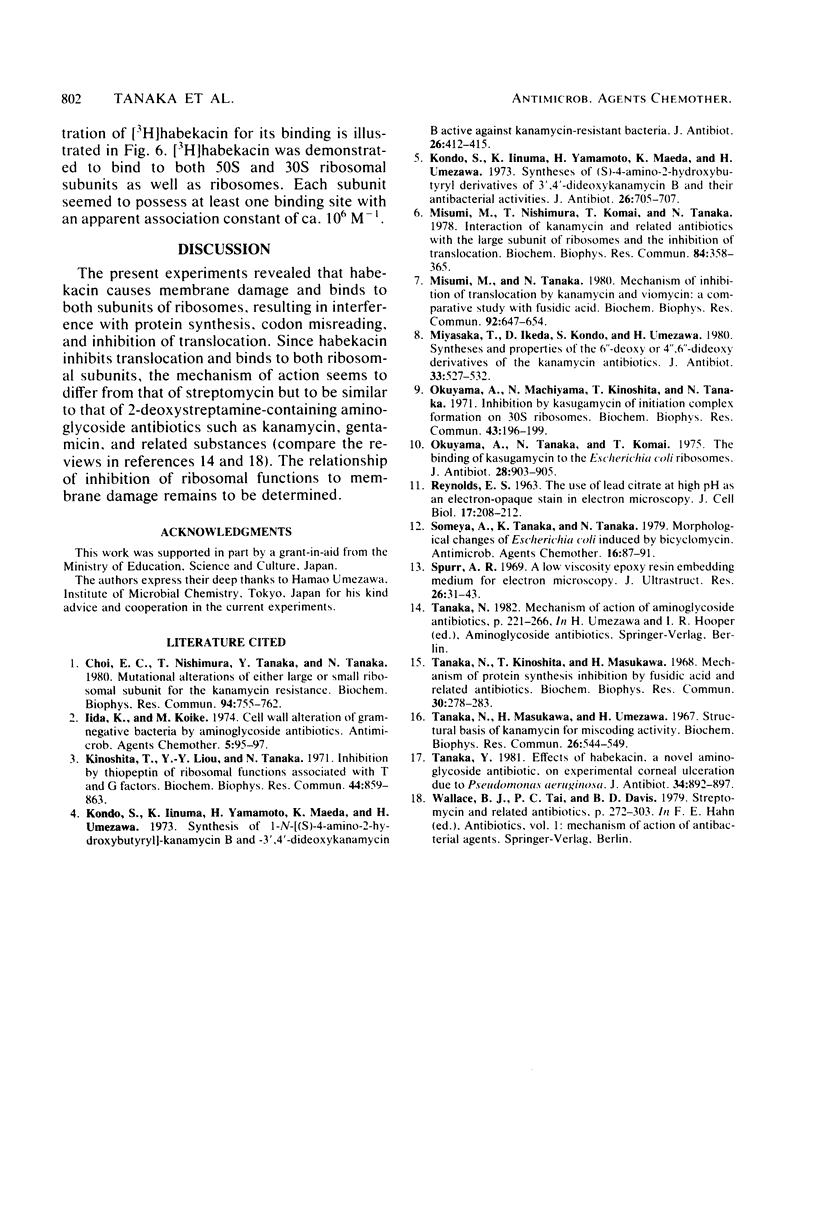
Images in this article
Selected References
These references are in PubMed. This may not be the complete list of references from this article.
- Choi E. C., Nishimura T., Tanaka N. Mutational alterations of either large or small ribosomal subunit for the kanamycin resistance. Biochem Biophys Res Commun. 1980 Jun 16;94(3):755–762. doi: 10.1016/0006-291x(80)91299-1. [DOI] [PubMed] [Google Scholar]
- Iida K., Koike M. Cell wall alterations of gram-negative bacteria by aminoglycoside antibiotics. Antimicrob Agents Chemother. 1974 Jan;5(1):95–97. doi: 10.1128/aac.5.1.95. [DOI] [PMC free article] [PubMed] [Google Scholar]
- Kinoshita T., Liou Y., Tanaka N. Inhibition by thiopeptin of ribosomal functions associated with T and G factors. Biochem Biophys Res Commun. 1971 Aug 20;44(4):859–863. doi: 10.1016/0006-291x(71)90790-x. [DOI] [PubMed] [Google Scholar]
- Kondo S., Iinuma K., Yamamoto H., Ikeda Y., Maeda K. Letter: Synthesis of (S)-4-amino-2-hydroxybutyryl derivatives of 3',4'-dideoxykanamycin B and their antibacterial activities. J Antibiot (Tokyo) 1973 Nov;26(11):705–707. doi: 10.7164/antibiotics.26.705. [DOI] [PubMed] [Google Scholar]
- Kondo S., Iinuma K., Yamamoto H., Maeda K., Umezawa H. Letter: Syntheses of 1-n-(S)-4-amino-2-hydroxybutyryl)-kanamycin B and -3', 4'-dideoxykanamycin B active against kanamycin-resistant bacteria. J Antibiot (Tokyo) 1973 Jul;26(7):412–415. doi: 10.7164/antibiotics.26.412. [DOI] [PubMed] [Google Scholar]
- Misumi M., Nishimura T., Komai T., Tanaka N. Interaction of kanamycin and related antibiotics with the large subunit of ribosomes and the inhibition of translocation. Biochem Biophys Res Commun. 1978 Sep 29;84(2):358–365. doi: 10.1016/0006-291x(78)90178-x. [DOI] [PubMed] [Google Scholar]
- Miyasaka T., Ikeda D., Kondo S., Umezawa H. Syntheses and properties of the 6"-deoxy or 4",6"-dideoxy derivatives of the kanamycin antibiotics. J Antibiot (Tokyo) 1980 May;33(5):527–532. doi: 10.7164/antibiotics.33.527. [DOI] [PubMed] [Google Scholar]
- Okuyama A., Machiyama N., Kinoshita T., Tanaka N. Inhibition by kasugamycin of initiation complex formation on 30S ribosomes. Biochem Biophys Res Commun. 1971 Apr 2;43(1):196–199. doi: 10.1016/s0006-291x(71)80106-7. [DOI] [PubMed] [Google Scholar]
- Okuyama A., Tanaka N., Komai T. The binding of kasugamycin to the Escherichia coli ribosomes. J Antibiot (Tokyo) 1975 Nov;28(11):903–905. doi: 10.7164/antibiotics.28.903. [DOI] [PubMed] [Google Scholar]
- REYNOLDS E. S. The use of lead citrate at high pH as an electron-opaque stain in electron microscopy. J Cell Biol. 1963 Apr;17:208–212. doi: 10.1083/jcb.17.1.208. [DOI] [PMC free article] [PubMed] [Google Scholar]
- Someya A., Tanaka K., Tanaka N. Morphological changes of Escherichia coli induced by bicyclomycin. Antimicrob Agents Chemother. 1979 Jul;16(1):87–91. doi: 10.1128/aac.16.1.87. [DOI] [PMC free article] [PubMed] [Google Scholar]
- Spurr A. R. A low-viscosity epoxy resin embedding medium for electron microscopy. J Ultrastruct Res. 1969 Jan;26(1):31–43. doi: 10.1016/s0022-5320(69)90033-1. [DOI] [PubMed] [Google Scholar]
- Tanaka N., Kinoshita T., Masukawa H. Mechanism of protein synthesis inhibition by fusidic acid and related antibiotics. Biochem Biophys Res Commun. 1968 Feb 15;30(3):278–283. doi: 10.1016/0006-291x(68)90447-6. [DOI] [PubMed] [Google Scholar]
- Tanaka N., Masukawa H., Umezawa H. Structural basis of kanamycin for miscoding activity. Biochem Biophys Res Commun. 1967 Mar 9;26(5):544–549. doi: 10.1016/0006-291x(67)90099-x. [DOI] [PubMed] [Google Scholar]
- Tanaka Y. Effects of habekacin, a novel aminoglycoside antibiotic, on experimental corneal ulceration due to Pseudomonas aeruginosa. J Antibiot (Tokyo) 1981 Jul;34(7):892–897. doi: 10.7164/antibiotics.34.892. [DOI] [PubMed] [Google Scholar]






